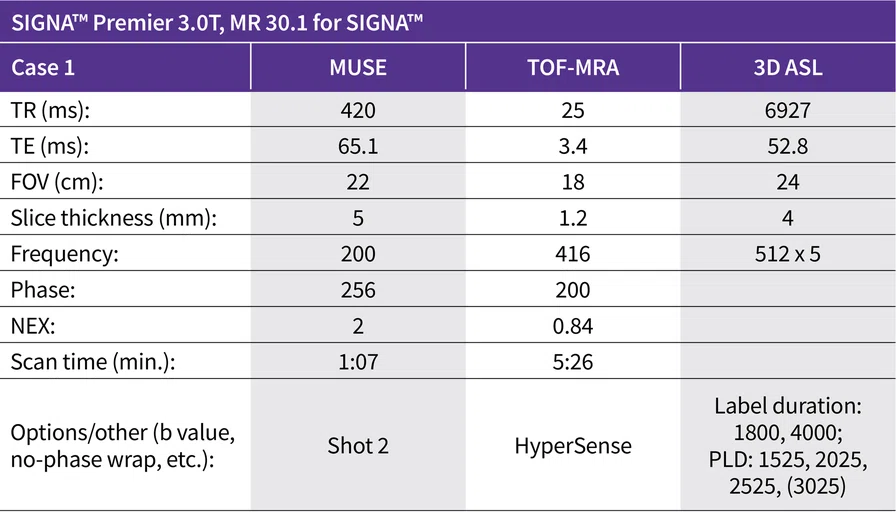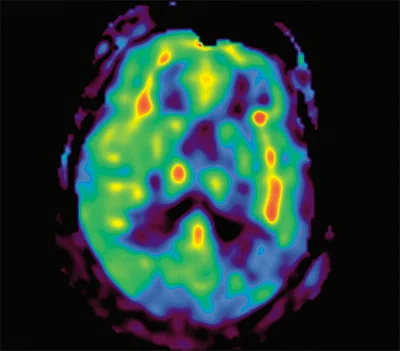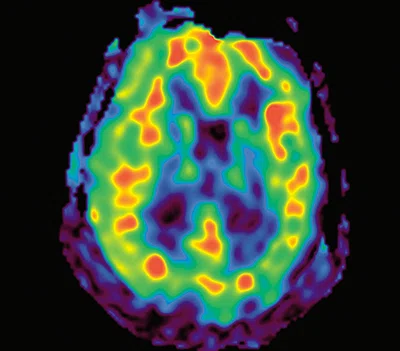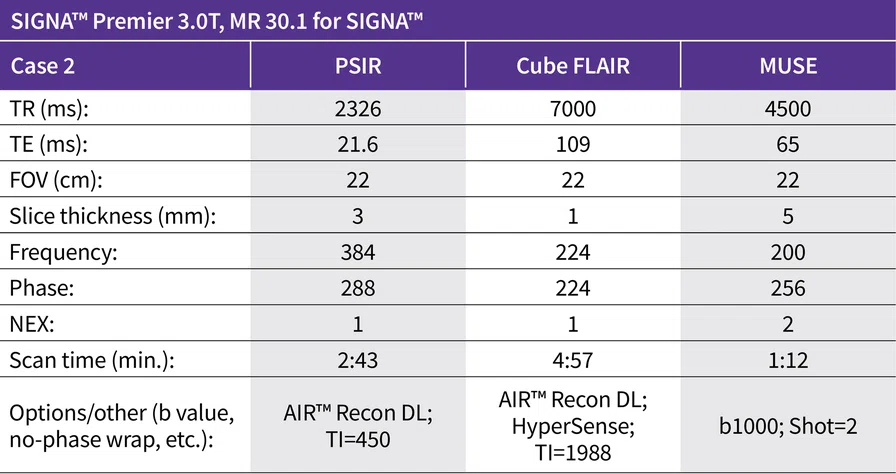1. Nogles TE, Galuska MA. Middle Cerebral Artery Stroke.
[Updated 2023 Apr 3]. In: StatPearls [Internet]. Treasure Island (FL): StatPearls Publishing; 2024 Jan-. Available from: https://www.ncbi.nlm.nih.gov/books/NBK556132/.
A1
Figure 3.
Case 2. An 80-year-old male was referred for preoperative evaluation of sphenoid wing meningioma. (A, B) Axial PSIR post-contrast, 0.57 x 0.76 x 3 mm, 2:43 min., with (A) conventional reconstruction and (B) AIR™ Recon DL. AIR™ Recon DL was also used in C-D and F-J. (C) Cube FLAIR, 0.98 x 0.98 x 1.0 mm, 4:57 min. (D) 3D SPGR, 0.68 x 0.85 x 1.2 mm, 2:04 min. (E) Axial MUSE b1000, 1.10 x 0.85 x 5.0 mm, 1:12 min. (F) Axial T2 FLAIR, 0.68 x 0.98 x 5.0 mm, 2:23 min. (G) Axial T2w, 0.52 x 0.57 x 5.0 mm, 1:21 min. (H) Axial T2*w, 0.52 x 1.10 x 5.0 mm, 1:21 min. (I) Axial T1 FLAIR, 0.68 x 0.98 x 5.0 mm, 1:21 min. (J) Axial T1w post-contrast, 0.68 x 0.98 x 5.0 mm, 1:38 min. (K) Fused image of 3D ASL and T1w.
A2
Figure 3.
Case 2. An 80-year-old male was referred for preoperative evaluation of sphenoid wing meningioma. (A, B) Axial PSIR post-contrast, 0.57 x 0.76 x 3 mm, 2:43 min., with (A) conventional reconstruction and (B) AIR™ Recon DL. AIR™ Recon DL was also used in C-D and F-J. (C) Cube FLAIR, 0.98 x 0.98 x 1.0 mm, 4:57 min. (D) 3D SPGR, 0.68 x 0.85 x 1.2 mm, 2:04 min. (E) Axial MUSE b1000, 1.10 x 0.85 x 5.0 mm, 1:12 min. (F) Axial T2 FLAIR, 0.68 x 0.98 x 5.0 mm, 2:23 min. (G) Axial T2w, 0.52 x 0.57 x 5.0 mm, 1:21 min. (H) Axial T2*w, 0.52 x 1.10 x 5.0 mm, 1:21 min. (I) Axial T1 FLAIR, 0.68 x 0.98 x 5.0 mm, 1:21 min. (J) Axial T1w post-contrast, 0.68 x 0.98 x 5.0 mm, 1:38 min. (K) Fused image of 3D ASL and T1w.
B1
Figure 3.
Case 2. An 80-year-old male was referred for preoperative evaluation of sphenoid wing meningioma. (A, B) Axial PSIR post-contrast, 0.57 x 0.76 x 3 mm, 2:43 min., with (A) conventional reconstruction and (B) AIR™ Recon DL. AIR™ Recon DL was also used in C-D and F-J. (C) Cube FLAIR, 0.98 x 0.98 x 1.0 mm, 4:57 min. (D) 3D SPGR, 0.68 x 0.85 x 1.2 mm, 2:04 min. (E) Axial MUSE b1000, 1.10 x 0.85 x 5.0 mm, 1:12 min. (F) Axial T2 FLAIR, 0.68 x 0.98 x 5.0 mm, 2:23 min. (G) Axial T2w, 0.52 x 0.57 x 5.0 mm, 1:21 min. (H) Axial T2*w, 0.52 x 1.10 x 5.0 mm, 1:21 min. (I) Axial T1 FLAIR, 0.68 x 0.98 x 5.0 mm, 1:21 min. (J) Axial T1w post-contrast, 0.68 x 0.98 x 5.0 mm, 1:38 min. (K) Fused image of 3D ASL and T1w.
B2
Figure 3.
Case 2. An 80-year-old male was referred for preoperative evaluation of sphenoid wing meningioma. (A, B) Axial PSIR post-contrast, 0.57 x 0.76 x 3 mm, 2:43 min., with (A) conventional reconstruction and (B) AIR™ Recon DL. AIR™ Recon DL was also used in C-D and F-J. (C) Cube FLAIR, 0.98 x 0.98 x 1.0 mm, 4:57 min. (D) 3D SPGR, 0.68 x 0.85 x 1.2 mm, 2:04 min. (E) Axial MUSE b1000, 1.10 x 0.85 x 5.0 mm, 1:12 min. (F) Axial T2 FLAIR, 0.68 x 0.98 x 5.0 mm, 2:23 min. (G) Axial T2w, 0.52 x 0.57 x 5.0 mm, 1:21 min. (H) Axial T2*w, 0.52 x 1.10 x 5.0 mm, 1:21 min. (I) Axial T1 FLAIR, 0.68 x 0.98 x 5.0 mm, 1:21 min. (J) Axial T1w post-contrast, 0.68 x 0.98 x 5.0 mm, 1:38 min. (K) Fused image of 3D ASL and T1w.
C
Figure 3.
Case 2. An 80-year-old male was referred for preoperative evaluation of sphenoid wing meningioma. (A, B) Axial PSIR post-contrast, 0.57 x 0.76 x 3 mm, 2:43 min., with (A) conventional reconstruction and (B) AIR™ Recon DL. AIR™ Recon DL was also used in C-D and F-J. (C) Cube FLAIR, 0.98 x 0.98 x 1.0 mm, 4:57 min. (D) 3D SPGR, 0.68 x 0.85 x 1.2 mm, 2:04 min. (E) Axial MUSE b1000, 1.10 x 0.85 x 5.0 mm, 1:12 min. (F) Axial T2 FLAIR, 0.68 x 0.98 x 5.0 mm, 2:23 min. (G) Axial T2w, 0.52 x 0.57 x 5.0 mm, 1:21 min. (H) Axial T2*w, 0.52 x 1.10 x 5.0 mm, 1:21 min. (I) Axial T1 FLAIR, 0.68 x 0.98 x 5.0 mm, 1:21 min. (J) Axial T1w post-contrast, 0.68 x 0.98 x 5.0 mm, 1:38 min. (K) Fused image of 3D ASL and T1w.
D
Figure 3.
Case 2. An 80-year-old male was referred for preoperative evaluation of sphenoid wing meningioma. (A, B) Axial PSIR post-contrast, 0.57 x 0.76 x 3 mm, 2:43 min., with (A) conventional reconstruction and (B) AIR™ Recon DL. AIR™ Recon DL was also used in C-D and F-J. (C) Cube FLAIR, 0.98 x 0.98 x 1.0 mm, 4:57 min. (D) 3D SPGR, 0.68 x 0.85 x 1.2 mm, 2:04 min. (E) Axial MUSE b1000, 1.10 x 0.85 x 5.0 mm, 1:12 min. (F) Axial T2 FLAIR, 0.68 x 0.98 x 5.0 mm, 2:23 min. (G) Axial T2w, 0.52 x 0.57 x 5.0 mm, 1:21 min. (H) Axial T2*w, 0.52 x 1.10 x 5.0 mm, 1:21 min. (I) Axial T1 FLAIR, 0.68 x 0.98 x 5.0 mm, 1:21 min. (J) Axial T1w post-contrast, 0.68 x 0.98 x 5.0 mm, 1:38 min. (K) Fused image of 3D ASL and T1w.
E
Figure 3.
Case 2. An 80-year-old male was referred for preoperative evaluation of sphenoid wing meningioma. (A, B) Axial PSIR post-contrast, 0.57 x 0.76 x 3 mm, 2:43 min., with (A) conventional reconstruction and (B) AIR™ Recon DL. AIR™ Recon DL was also used in C-D and F-J. (C) Cube FLAIR, 0.98 x 0.98 x 1.0 mm, 4:57 min. (D) 3D SPGR, 0.68 x 0.85 x 1.2 mm, 2:04 min. (E) Axial MUSE b1000, 1.10 x 0.85 x 5.0 mm, 1:12 min. (F) Axial T2 FLAIR, 0.68 x 0.98 x 5.0 mm, 2:23 min. (G) Axial T2w, 0.52 x 0.57 x 5.0 mm, 1:21 min. (H) Axial T2*w, 0.52 x 1.10 x 5.0 mm, 1:21 min. (I) Axial T1 FLAIR, 0.68 x 0.98 x 5.0 mm, 1:21 min. (J) Axial T1w post-contrast, 0.68 x 0.98 x 5.0 mm, 1:38 min. (K) Fused image of 3D ASL and T1w.
F
Figure 3.
Case 2. An 80-year-old male was referred for preoperative evaluation of sphenoid wing meningioma. (A, B) Axial PSIR post-contrast, 0.57 x 0.76 x 3 mm, 2:43 min., with (A) conventional reconstruction and (B) AIR™ Recon DL. AIR™ Recon DL was also used in C-D and F-J. (C) Cube FLAIR, 0.98 x 0.98 x 1.0 mm, 4:57 min. (D) 3D SPGR, 0.68 x 0.85 x 1.2 mm, 2:04 min. (E) Axial MUSE b1000, 1.10 x 0.85 x 5.0 mm, 1:12 min. (F) Axial T2 FLAIR, 0.68 x 0.98 x 5.0 mm, 2:23 min. (G) Axial T2w, 0.52 x 0.57 x 5.0 mm, 1:21 min. (H) Axial T2*w, 0.52 x 1.10 x 5.0 mm, 1:21 min. (I) Axial T1 FLAIR, 0.68 x 0.98 x 5.0 mm, 1:21 min. (J) Axial T1w post-contrast, 0.68 x 0.98 x 5.0 mm, 1:38 min. (K) Fused image of 3D ASL and T1w.
G
Figure 3.
Case 2. An 80-year-old male was referred for preoperative evaluation of sphenoid wing meningioma. (A, B) Axial PSIR post-contrast, 0.57 x 0.76 x 3 mm, 2:43 min., with (A) conventional reconstruction and (B) AIR™ Recon DL. AIR™ Recon DL was also used in C-D and F-J. (C) Cube FLAIR, 0.98 x 0.98 x 1.0 mm, 4:57 min. (D) 3D SPGR, 0.68 x 0.85 x 1.2 mm, 2:04 min. (E) Axial MUSE b1000, 1.10 x 0.85 x 5.0 mm, 1:12 min. (F) Axial T2 FLAIR, 0.68 x 0.98 x 5.0 mm, 2:23 min. (G) Axial T2w, 0.52 x 0.57 x 5.0 mm, 1:21 min. (H) Axial T2*w, 0.52 x 1.10 x 5.0 mm, 1:21 min. (I) Axial T1 FLAIR, 0.68 x 0.98 x 5.0 mm, 1:21 min. (J) Axial T1w post-contrast, 0.68 x 0.98 x 5.0 mm, 1:38 min. (K) Fused image of 3D ASL and T1w.
Figure 3.
Case 2. An 80-year-old male was referred for preoperative evaluation of sphenoid wing meningioma. (A, B) Axial PSIR post-contrast, 0.57 x 0.76 x 3 mm, 2:43 min., with (A) conventional reconstruction and (B) AIR™ Recon DL. AIR™ Recon DL was also used in C-D and F-J. (C) Cube FLAIR, 0.98 x 0.98 x 1.0 mm, 4:57 min. (D) 3D SPGR, 0.68 x 0.85 x 1.2 mm, 2:04 min. (E) Axial MUSE b1000, 1.10 x 0.85 x 5.0 mm, 1:12 min. (F) Axial T2 FLAIR, 0.68 x 0.98 x 5.0 mm, 2:23 min. (G) Axial T2w, 0.52 x 0.57 x 5.0 mm, 1:21 min. (H) Axial T2*w, 0.52 x 1.10 x 5.0 mm, 1:21 min. (I) Axial T1 FLAIR, 0.68 x 0.98 x 5.0 mm, 1:21 min. (J) Axial T1w post-contrast, 0.68 x 0.98 x 5.0 mm, 1:38 min. (K) Fused image of 3D ASL and T1w.
H
I
Figure 3.
Case 2. An 80-year-old male was referred for preoperative evaluation of sphenoid wing meningioma. (A, B) Axial PSIR post-contrast, 0.57 x 0.76 x 3 mm, 2:43 min., with (A) conventional reconstruction and (B) AIR™ Recon DL. AIR™ Recon DL was also used in C-D and F-J. (C) Cube FLAIR, 0.98 x 0.98 x 1.0 mm, 4:57 min. (D) 3D SPGR, 0.68 x 0.85 x 1.2 mm, 2:04 min. (E) Axial MUSE b1000, 1.10 x 0.85 x 5.0 mm, 1:12 min. (F) Axial T2 FLAIR, 0.68 x 0.98 x 5.0 mm, 2:23 min. (G) Axial T2w, 0.52 x 0.57 x 5.0 mm, 1:21 min. (H) Axial T2*w, 0.52 x 1.10 x 5.0 mm, 1:21 min. (I) Axial T1 FLAIR, 0.68 x 0.98 x 5.0 mm, 1:21 min. (J) Axial T1w post-contrast, 0.68 x 0.98 x 5.0 mm, 1:38 min. (K) Fused image of 3D ASL and T1w.
J
Figure 3.
Case 2. An 80-year-old male was referred for preoperative evaluation of sphenoid wing meningioma. (A, B) Axial PSIR post-contrast, 0.57 x 0.76 x 3 mm, 2:43 min., with (A) conventional reconstruction and (B) AIR™ Recon DL. AIR™ Recon DL was also used in C-D and F-J. (C) Cube FLAIR, 0.98 x 0.98 x 1.0 mm, 4:57 min. (D) 3D SPGR, 0.68 x 0.85 x 1.2 mm, 2:04 min. (E) Axial MUSE b1000, 1.10 x 0.85 x 5.0 mm, 1:12 min. (F) Axial T2 FLAIR, 0.68 x 0.98 x 5.0 mm, 2:23 min. (G) Axial T2w, 0.52 x 0.57 x 5.0 mm, 1:21 min. (H) Axial T2*w, 0.52 x 1.10 x 5.0 mm, 1:21 min. (I) Axial T1 FLAIR, 0.68 x 0.98 x 5.0 mm, 1:21 min. (J) Axial T1w post-contrast, 0.68 x 0.98 x 5.0 mm, 1:38 min. (K) Fused image of 3D ASL and T1w.
K
Figure 3.
Case 2. An 80-year-old male was referred for preoperative evaluation of sphenoid wing meningioma. (A, B) Axial PSIR post-contrast, 0.57 x 0.76 x 3 mm, 2:43 min., with (A) conventional reconstruction and (B) AIR™ Recon DL. AIR™ Recon DL was also used in C-D and F-J. (C) Cube FLAIR, 0.98 x 0.98 x 1.0 mm, 4:57 min. (D) 3D SPGR, 0.68 x 0.85 x 1.2 mm, 2:04 min. (E) Axial MUSE b1000, 1.10 x 0.85 x 5.0 mm, 1:12 min. (F) Axial T2 FLAIR, 0.68 x 0.98 x 5.0 mm, 2:23 min. (G) Axial T2w, 0.52 x 0.57 x 5.0 mm, 1:21 min. (H) Axial T2*w, 0.52 x 1.10 x 5.0 mm, 1:21 min. (I) Axial T1 FLAIR, 0.68 x 0.98 x 5.0 mm, 1:21 min. (J) Axial T1w post-contrast, 0.68 x 0.98 x 5.0 mm, 1:38 min. (K) Fused image of 3D ASL and T1w.
A
Figure 1.
Case 1, a 74-year-old female referred for left MCA occlusion follow-up. 3D ASL CBF map with flexible label duration was utilized. (A-C) 3D ASL with label duration of 4000 ms and (A) PLD=1525 ms, (B) PLD=2025 ms and (C) PLD=2525 ms; (D) TOF MRA; (E-G) 3D ASL with label duration of 1800 ms and (E) PLD=1525 ms, (F) PLD=2025 ms and (G) PLD=2525 ms; and (H) MUSE DWI.
B
Figure 1.
Case 1, a 74-year-old female referred for left MCA occlusion follow-up. 3D ASL CBF map with flexible label duration was utilized. (A-C) 3D ASL with label duration of 4000 ms and (A) PLD=1525 ms, (B) PLD=2025 ms and (C) PLD=2525 ms; (D) TOF MRA; (E-G) 3D ASL with label duration of 1800 ms and (E) PLD=1525 ms, (F) PLD=2025 ms and (G) PLD=2525 ms; and (H) MUSE DWI.
C
Figure 3.
Case 1, a 74-year-old female referred for left MCA occlusion follow-up. 3D ASL CBF map with flexible label duration was utilized. (A-C) 3D ASL with label duration of 4000 ms and (A) PLD=1525 ms, (B) PLD=2025 ms and (C) PLD=2525 ms; (D) TOF MRA; (E-G) 3D ASL with label duration of 1800 ms and (E) PLD=1525 ms, (F) PLD=2025 ms and (G) PLD=2525 ms; and (H) MUSE DWI.
D
Figure 1.
Case 1, a 74-year-old female referred for left MCA occlusion follow-up. 3D ASL CBF map with flexible label duration was utilized. (A-C) 3D ASL with label duration of 4000 ms and (A) PLD=1525 ms, (B) PLD=2025 ms and (C) PLD=2525 ms; (D) TOF MRA; (E-G) 3D ASL with label duration of 1800 ms and (E) PLD=1525 ms, (F) PLD=2025 ms and (G) PLD=2525 ms; and (H) MUSE DWI.
E
Figure 1.
Case 1, a 74-year-old female referred for left MCA occlusion follow-up. 3D ASL CBF map with flexible label duration was utilized. (A-C) 3D ASL with label duration of 4000 ms and (A) PLD=1525 ms, (B) PLD=2025 ms and (C) PLD=2525 ms; (D) TOF MRA; (E-G) 3D ASL with label duration of 1800 ms and (E) PLD=1525 ms, (F) PLD=2025 ms and (G) PLD=2525 ms; and (H) MUSE DWI.
F
Figure 1.
Case 1, a 74-year-old female referred for left MCA occlusion follow-up. 3D ASL CBF map with flexible label duration was utilized. (A-C) 3D ASL with label duration of 4000 ms and (A) PLD=1525 ms, (B) PLD=2025 ms and (C) PLD=2525 ms; (D) TOF MRA; (E-G) 3D ASL with label duration of 1800 ms and (E) PLD=1525 ms, (F) PLD=2025 ms and (G) PLD=2525 ms; and (H) MUSE DWI.
G
Figure 1.
Case 1, a 74-year-old female referred for left MCA occlusion follow-up. 3D ASL CBF map with flexible label duration was utilized. (A-C) 3D ASL with label duration of 4000 ms and (A) PLD=1525 ms, (B) PLD=2025 ms and (C) PLD=2525 ms; (D) TOF MRA; (E-G) 3D ASL with label duration of 1800 ms and (E) PLD=1525 ms, (F) PLD=2025 ms and (G) PLD=2525 ms; and (H) MUSE DWI.
H
Figure 1.
Case 1, a 74-year-old female referred for left MCA occlusion follow-up. 3D ASL CBF map with flexible label duration was utilized. (A-C) 3D ASL with label duration of 4000 ms and (A) PLD=1525 ms, (B) PLD=2025 ms and (C) PLD=2525 ms; (D) TOF MRA; (E-G) 3D ASL with label duration of 1800 ms and (E) PLD=1525 ms, (F) PLD=2025 ms and (G) PLD=2525 ms; and (H) MUSE DWI.
2. National Cancer Institute. Meningioma Diagnosis and Treatment. NCI-Connect. Accessed March 5, 2024.
Available at: https://www.cancer.gov/rare-brain-spine-tumor/tumors/meningioma.
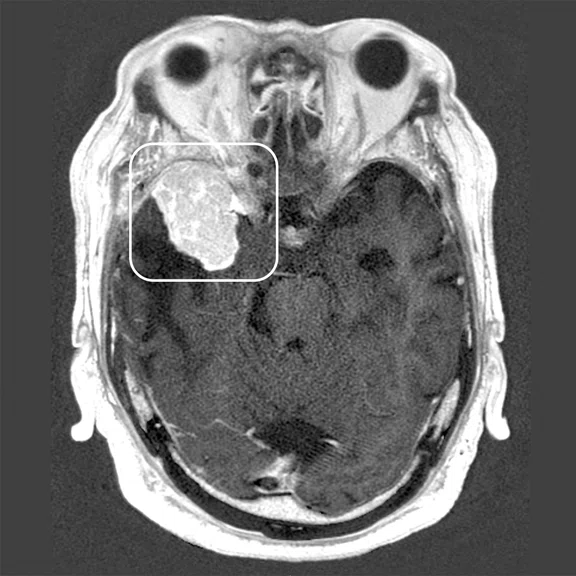
A 1
Figure 3.
Case 2. An 80-year-old male was referred for preoperative evaluation of sphenoid wing meningioma. (A, B) Axial PSIR post-contrast, 0.57 x 0.76 x 3 mm, 2:43 min., with (A) conventional reconstruction and (B) AIR™ Recon DL. AIR™ Recon DL was also used in C-D and F-J. (C) Cube FLAIR, 0.98 x 0.98 x 1.0 mm, 4:57 min. (D) 3D SPGR, 0.68 x 0.85 x 1.2 mm, 2:04 min. (E) Axial MUSE b1000, 1.10 x 0.85 x 5.0 mm, 1:12 min. (F) Axial T2 FLAIR, 0.68 x 0.98 x 5.0 mm, 2:23 min. (G) Axial T2w, 0.52 x 0.57 x 5.0 mm, 1:21 min. (H) Axial T2*w, 0.52 x 1.10 x 5.0 mm, 1:21 min. (I) Axial T1 FLAIR, 0.68 x 0.98 x 5.0 mm, 1:21 min. (J) Axial T1w post-contrast, 0.68 x 0.98 x 5.0 mm, 1:38 min. (K) Fused image of 3D ASL and T1w.
B1
Figure 3.
Case 2. An 80-year-old male was referred for preoperative evaluation of sphenoid wing meningioma. (A, B) Axial PSIR post-contrast, 0.57 x 0.76 x 3 mm, 2:43 min., with (A) conventional reconstruction and (B) AIR™ Recon DL. AIR™ Recon DL was also used in C-D and F-J. (C) Cube FLAIR, 0.98 x 0.98 x 1.0 mm, 4:57 min. (D) 3D SPGR, 0.68 x 0.85 x 1.2 mm, 2:04 min. (E) Axial MUSE b1000, 1.10 x 0.85 x 5.0 mm, 1:12 min. (F) Axial T2 FLAIR, 0.68 x 0.98 x 5.0 mm, 2:23 min. (G) Axial T2w, 0.52 x 0.57 x 5.0 mm, 1:21 min. (H) Axial T2*w, 0.52 x 1.10 x 5.0 mm, 1:21 min. (I) Axial T1 FLAIR, 0.68 x 0.98 x 5.0 mm, 1:21 min. (J) Axial T1w post-contrast, 0.68 x 0.98 x 5.0 mm, 1:38 min. (K) Fused image of 3D ASL and T1w.
C
Figure #.
Figure Copy.
D
Figure 3.
Case 2. An 80-year-old male was referred for preoperative evaluation of sphenoid wing meningioma. (A, B) Axial PSIR post-contrast, 0.57 x 0.76 x 3 mm, 2:43 min., with (A) conventional reconstruction and (B) AIR™ Recon DL. AIR™ Recon DL was also used in C-D and F-J. (C) Cube FLAIR, 0.98 x 0.98 x 1.0 mm, 4:57 min. (D) 3D SPGR, 0.68 x 0.85 x 1.2 mm, 2:04 min. (E) Axial MUSE b1000, 1.10 x 0.85 x 5.0 mm, 1:12 min. (F) Axial T2 FLAIR, 0.68 x 0.98 x 5.0 mm, 2:23 min. (G) Axial T2w, 0.52 x 0.57 x 5.0 mm, 1:21 min. (H) Axial T2*w, 0.52 x 1.10 x 5.0 mm, 1:21 min. (I) Axial T1 FLAIR, 0.68 x 0.98 x 5.0 mm, 1:21 min. (J) Axial T1w post-contrast, 0.68 x 0.98 x 5.0 mm, 1:38 min. (K) Fused image of 3D ASL and T1w.
E
Figure 3.
Case 2. An 80-year-old male was referred for preoperative evaluation of sphenoid wing meningioma. (A, B) Axial PSIR post-contrast, 0.57 x 0.76 x 3 mm, 2:43 min., with (A) conventional reconstruction and (B) AIR™ Recon DL. AIR™ Recon DL was also used in C-D and F-J. (C) Cube FLAIR, 0.98 x 0.98 x 1.0 mm, 4:57 min. (D) 3D SPGR, 0.68 x 0.85 x 1.2 mm, 2:04 min. (E) Axial MUSE b1000, 1.10 x 0.85 x 5.0 mm, 1:12 min. (F) Axial T2 FLAIR, 0.68 x 0.98 x 5.0 mm, 2:23 min. (G) Axial T2w, 0.52 x 0.57 x 5.0 mm, 1:21 min. (H) Axial T2*w, 0.52 x 1.10 x 5.0 mm, 1:21 min. (I) Axial T1 FLAIR, 0.68 x 0.98 x 5.0 mm, 1:21 min. (J) Axial T1w post-contrast, 0.68 x 0.98 x 5.0 mm, 1:38 min. (K) Fused image of 3D ASL and T1w.
F
Figure 3.
Case 2. An 80-year-old male was referred for preoperative evaluation of sphenoid wing meningioma. (A, B) Axial PSIR post-contrast, 0.57 x 0.76 x 3 mm, 2:43 min., with (A) conventional reconstruction and (B) AIR™ Recon DL. AIR™ Recon DL was also used in C-D and F-J. (C) Cube FLAIR, 0.98 x 0.98 x 1.0 mm, 4:57 min. (D) 3D SPGR, 0.68 x 0.85 x 1.2 mm, 2:04 min. (E) Axial MUSE b1000, 1.10 x 0.85 x 5.0 mm, 1:12 min. (F) Axial T2 FLAIR, 0.68 x 0.98 x 5.0 mm, 2:23 min. (G) Axial T2w, 0.52 x 0.57 x 5.0 mm, 1:21 min. (H) Axial T2*w, 0.52 x 1.10 x 5.0 mm, 1:21 min. (I) Axial T1 FLAIR, 0.68 x 0.98 x 5.0 mm, 1:21 min. (J) Axial T1w post-contrast, 0.68 x 0.98 x 5.0 mm, 1:38 min. (K) Fused image of 3D ASL and T1w.
G
Figure 3.
Case 2. An 80-year-old male was referred for preoperative evaluation of sphenoid wing meningioma. (A, B) Axial PSIR post-contrast, 0.57 x 0.76 x 3 mm, 2:43 min., with (A) conventional reconstruction and (B) AIR™ Recon DL. AIR™ Recon DL was also used in C-D and F-J. (C) Cube FLAIR, 0.98 x 0.98 x 1.0 mm, 4:57 min. (D) 3D SPGR, 0.68 x 0.85 x 1.2 mm, 2:04 min. (E) Axial MUSE b1000, 1.10 x 0.85 x 5.0 mm, 1:12 min. (F) Axial T2 FLAIR, 0.68 x 0.98 x 5.0 mm, 2:23 min. (G) Axial T2w, 0.52 x 0.57 x 5.0 mm, 1:21 min. (H) Axial T2*w, 0.52 x 1.10 x 5.0 mm, 1:21 min. (I) Axial T1 FLAIR, 0.68 x 0.98 x 5.0 mm, 1:21 min. (J) Axial T1w post-contrast, 0.68 x 0.98 x 5.0 mm, 1:38 min. (K) Fused image of 3D ASL and T1w.
H
Figure 3.
Case 2. An 80-year-old male was referred for preoperative evaluation of sphenoid wing meningioma. (A, B) Axial PSIR post-contrast, 0.57 x 0.76 x 3 mm, 2:43 min., with (A) conventional reconstruction and (B) AIR™ Recon DL. AIR™ Recon DL was also used in C-D and F-J. (C) Cube FLAIR, 0.98 x 0.98 x 1.0 mm, 4:57 min. (D) 3D SPGR, 0.68 x 0.85 x 1.2 mm, 2:04 min. (E) Axial MUSE b1000, 1.10 x 0.85 x 5.0 mm, 1:12 min. (F) Axial T2 FLAIR, 0.68 x 0.98 x 5.0 mm, 2:23 min. (G) Axial T2w, 0.52 x 0.57 x 5.0 mm, 1:21 min. (H) Axial T2*w, 0.52 x 1.10 x 5.0 mm, 1:21 min. (I) Axial T1 FLAIR, 0.68 x 0.98 x 5.0 mm, 1:21 min. (J) Axial T1w post-contrast, 0.68 x 0.98 x 5.0 mm, 1:38 min. (K) Fused image of 3D ASL and T1w.
I
Figure 3.
Case 2. An 80-year-old male was referred for preoperative evaluation of sphenoid wing meningioma. (A, B) Axial PSIR post-contrast, 0.57 x 0.76 x 3 mm, 2:43 min., with (A) conventional reconstruction and (B) AIR™ Recon DL. AIR™ Recon DL was also used in C-D and F-J. (C) Cube FLAIR, 0.98 x 0.98 x 1.0 mm, 4:57 min. (D) 3D SPGR, 0.68 x 0.85 x 1.2 mm, 2:04 min. (E) Axial MUSE b1000, 1.10 x 0.85 x 5.0 mm, 1:12 min. (F) Axial T2 FLAIR, 0.68 x 0.98 x 5.0 mm, 2:23 min. (G) Axial T2w, 0.52 x 0.57 x 5.0 mm, 1:21 min. (H) Axial T2*w, 0.52 x 1.10 x 5.0 mm, 1:21 min. (I) Axial T1 FLAIR, 0.68 x 0.98 x 5.0 mm, 1:21 min. (J) Axial T1w post-contrast, 0.68 x 0.98 x 5.0 mm, 1:38 min. (K) Fused image of 3D ASL and T1w.
J
Figure 3.
Case 2. An 80-year-old male was referred for preoperative evaluation of sphenoid wing meningioma. (A, B) Axial PSIR post-contrast, 0.57 x 0.76 x 3 mm, 2:43 min., with (A) conventional reconstruction and (B) AIR™ Recon DL. AIR™ Recon DL was also used in C-D and F-J. (C) Cube FLAIR, 0.98 x 0.98 x 1.0 mm, 4:57 min. (D) 3D SPGR, 0.68 x 0.85 x 1.2 mm, 2:04 min. (E) Axial MUSE b1000, 1.10 x 0.85 x 5.0 mm, 1:12 min. (F) Axial T2 FLAIR, 0.68 x 0.98 x 5.0 mm, 2:23 min. (G) Axial T2w, 0.52 x 0.57 x 5.0 mm, 1:21 min. (H) Axial T2*w, 0.52 x 1.10 x 5.0 mm, 1:21 min. (I) Axial T1 FLAIR, 0.68 x 0.98 x 5.0 mm, 1:21 min. (J) Axial T1w post-contrast, 0.68 x 0.98 x 5.0 mm, 1:38 min. (K) Fused image of 3D ASL and T1w.
A2
Figure 3.
Case 2. An 80-year-old male was referred for preoperative evaluation of sphenoid wing meningioma. (A, B) Axial PSIR post-contrast, 0.57 x 0.76 x 3 mm, 2:43 min., with (A) conventional reconstruction and (B) AIR™ Recon DL. AIR™ Recon DL was also used in C-D and F-J. (C) Cube FLAIR, 0.98 x 0.98 x 1.0 mm, 4:57 min. (D) 3D SPGR, 0.68 x 0.85 x 1.2 mm, 2:04 min. (E) Axial MUSE b1000, 1.10 x 0.85 x 5.0 mm, 1:12 min. (F) Axial T2 FLAIR, 0.68 x 0.98 x 5.0 mm, 2:23 min. (G) Axial T2w, 0.52 x 0.57 x 5.0 mm, 1:21 min. (H) Axial T2*w, 0.52 x 1.10 x 5.0 mm, 1:21 min. (I) Axial T1 FLAIR, 0.68 x 0.98 x 5.0 mm, 1:21 min. (J) Axial T1w post-contrast, 0.68 x 0.98 x 5.0 mm, 1:38 min. (K) Fused image of 3D ASL and T1w.
B2
Figure 3.
Case 2. An 80-year-old male was referred for preoperative evaluation of sphenoid wing meningioma. (A, B) Axial PSIR post-contrast, 0.57 x 0.76 x 3 mm, 2:43 min., with (A) conventional reconstruction and (B) AIR™ Recon DL. AIR™ Recon DL was also used in C-D and F-J. (C) Cube FLAIR, 0.98 x 0.98 x 1.0 mm, 4:57 min. (D) 3D SPGR, 0.68 x 0.85 x 1.2 mm, 2:04 min. (E) Axial MUSE b1000, 1.10 x 0.85 x 5.0 mm, 1:12 min. (F) Axial T2 FLAIR, 0.68 x 0.98 x 5.0 mm, 2:23 min. (G) Axial T2w, 0.52 x 0.57 x 5.0 mm, 1:21 min. (H) Axial T2*w, 0.52 x 1.10 x 5.0 mm, 1:21 min. (I) Axial T1 FLAIR, 0.68 x 0.98 x 5.0 mm, 1:21 min. (J) Axial T1w post-contrast, 0.68 x 0.98 x 5.0 mm, 1:38 min. (K) Fused image of 3D ASL and T1w.
K
Figure #.
Figure Copy.
C
Figure 3.
Case 2. An 80-year-old male was referred for preoperative evaluation of sphenoid wing meningioma. (A, B) Axial PSIR post-contrast, 0.57 x 0.76 x 3 mm, 2:43 min., with (A) conventional reconstruction and (B) AIR™ Recon DL. AIR™ Recon DL was also used in C-D and F-J. (C) Cube FLAIR, 0.98 x 0.98 x 1.0 mm, 4:57 min. (D) 3D SPGR, 0.68 x 0.85 x 1.2 mm, 2:04 min. (E) Axial MUSE b1000, 1.10 x 0.85 x 5.0 mm, 1:12 min. (F) Axial T2 FLAIR, 0.68 x 0.98 x 5.0 mm, 2:23 min. (G) Axial T2w, 0.52 x 0.57 x 5.0 mm, 1:21 min. (H) Axial T2*w, 0.52 x 1.10 x 5.0 mm, 1:21 min. (I) Axial T1 FLAIR, 0.68 x 0.98 x 5.0 mm, 1:21 min. (J) Axial T1w post-contrast, 0.68 x 0.98 x 5.0 mm, 1:38 min. (K) Fused image of 3D ASL and T1w.
A1
Figure 3.
Case 2. An 80-year-old male was referred for preoperative evaluation of sphenoid wing meningioma. (A, B) Axial PSIR post-contrast, 0.57 x 0.76 x 3 mm, 2:43 min., with (A) conventional reconstruction and (B) AIR™ Recon DL. AIR™ Recon DL was also used in C-D and F-J. (C) Cube FLAIR, 0.98 x 0.98 x 1.0 mm, 4:57 min. (D) 3D SPGR, 0.68 x 0.85 x 1.2 mm, 2:04 min. (E) Axial MUSE b1000, 1.10 x 0.85 x 5.0 mm, 1:12 min. (F) Axial T2 FLAIR, 0.68 x 0.98 x 5.0 mm, 2:23 min. (G) Axial T2w, 0.52 x 0.57 x 5.0 mm, 1:21 min. (H) Axial T2*w, 0.52 x 1.10 x 5.0 mm, 1:21 min. (I) Axial T1 FLAIR, 0.68 x 0.98 x 5.0 mm, 1:21 min. (J) Axial T1w post-contrast, 0.68 x 0.98 x 5.0 mm, 1:38 min. (K) Fused image of 3D ASL and T1w.
B1
Figure 3.
Case 2. An 80-year-old male was referred for preoperative evaluation of sphenoid wing meningioma. (A, B) Axial PSIR post-contrast, 0.57 x 0.76 x 3 mm, 2:43 min., with (A) conventional reconstruction and (B) AIR™ Recon DL. AIR™ Recon DL was also used in C-D and F-J. (C) Cube FLAIR, 0.98 x 0.98 x 1.0 mm, 4:57 min. (D) 3D SPGR, 0.68 x 0.85 x 1.2 mm, 2:04 min. (E) Axial MUSE b1000, 1.10 x 0.85 x 5.0 mm, 1:12 min. (F) Axial T2 FLAIR, 0.68 x 0.98 x 5.0 mm, 2:23 min. (G) Axial T2w, 0.52 x 0.57 x 5.0 mm, 1:21 min. (H) Axial T2*w, 0.52 x 1.10 x 5.0 mm, 1:21 min. (I) Axial T1 FLAIR, 0.68 x 0.98 x 5.0 mm, 1:21 min. (J) Axial T1w post-contrast, 0.68 x 0.98 x 5.0 mm, 1:38 min. (K) Fused image of 3D ASL and T1w.
D
Figure #.
Figure Copy.
B2
Figure 3.
Case 2. An 80-year-old male was referred for preoperative evaluation of sphenoid wing meningioma. (A, B) Axial PSIR post-contrast, 0.57 x 0.76 x 3 mm, 2:43 min., with (A) conventional reconstruction and (B) AIR™ Recon DL. AIR™ Recon DL was also used in C-D and F-J. (C) Cube FLAIR, 0.98 x 0.98 x 1.0 mm, 4:57 min. (D) 3D SPGR, 0.68 x 0.85 x 1.2 mm, 2:04 min. (E) Axial MUSE b1000, 1.10 x 0.85 x 5.0 mm, 1:12 min. (F) Axial T2 FLAIR, 0.68 x 0.98 x 5.0 mm, 2:23 min. (G) Axial T2w, 0.52 x 0.57 x 5.0 mm, 1:21 min. (H) Axial T2*w, 0.52 x 1.10 x 5.0 mm, 1:21 min. (I) Axial T1 FLAIR, 0.68 x 0.98 x 5.0 mm, 1:21 min. (J) Axial T1w post-contrast, 0.68 x 0.98 x 5.0 mm, 1:38 min. (K) Fused image of 3D ASL and T1w.
C
Figure 3.
Case 2. An 80-year-old male was referred for preoperative evaluation of sphenoid wing meningioma. (A, B) Axial PSIR post-contrast, 0.57 x 0.76 x 3 mm, 2:43 min., with (A) conventional reconstruction and (B) AIR™ Recon DL. AIR™ Recon DL was also used in C-D and F-J. (C) Cube FLAIR, 0.98 x 0.98 x 1.0 mm, 4:57 min. (D) 3D SPGR, 0.68 x 0.85 x 1.2 mm, 2:04 min. (E) Axial MUSE b1000, 1.10 x 0.85 x 5.0 mm, 1:12 min. (F) Axial T2 FLAIR, 0.68 x 0.98 x 5.0 mm, 2:23 min. (G) Axial T2w, 0.52 x 0.57 x 5.0 mm, 1:21 min. (H) Axial T2*w, 0.52 x 1.10 x 5.0 mm, 1:21 min. (I) Axial T1 FLAIR, 0.68 x 0.98 x 5.0 mm, 1:21 min. (J) Axial T1w post-contrast, 0.68 x 0.98 x 5.0 mm, 1:38 min. (K) Fused image of 3D ASL and T1w.
K
Figure 3.
Case 2. An 80-year-old male was referred for preoperative evaluation of sphenoid wing meningioma. (A, B) Axial PSIR post-contrast, 0.57 x 0.76 x 3 mm, 2:43 min., with (A) conventional reconstruction and (B) AIR™ Recon DL. AIR™ Recon DL was also used in C-D and F-J. (C) Cube FLAIR, 0.98 x 0.98 x 1.0 mm, 4:57 min. (D) 3D SPGR, 0.68 x 0.85 x 1.2 mm, 2:04 min. (E) Axial MUSE b1000, 1.10 x 0.85 x 5.0 mm, 1:12 min. (F) Axial T2 FLAIR, 0.68 x 0.98 x 5.0 mm, 2:23 min. (G) Axial T2w, 0.52 x 0.57 x 5.0 mm, 1:21 min. (H) Axial T2*w, 0.52 x 1.10 x 5.0 mm, 1:21 min. (I) Axial T1 FLAIR, 0.68 x 0.98 x 5.0 mm, 1:21 min. (J) Axial T1w post-contrast, 0.68 x 0.98 x 5.0 mm, 1:38 min. (K) Fused image of 3D ASL and T1w.
E
Figure 3.
Case 2. An 80-year-old male was referred for preoperative evaluation of sphenoid wing meningioma. (A, B) Axial PSIR post-contrast, 0.57 x 0.76 x 3 mm, 2:43 min., with (A) conventional reconstruction and (B) AIR™ Recon DL. AIR™ Recon DL was also used in C-D and F-J. (C) Cube FLAIR, 0.98 x 0.98 x 1.0 mm, 4:57 min. (D) 3D SPGR, 0.68 x 0.85 x 1.2 mm, 2:04 min. (E) Axial MUSE b1000, 1.10 x 0.85 x 5.0 mm, 1:12 min. (F) Axial T2 FLAIR, 0.68 x 0.98 x 5.0 mm, 2:23 min. (G) Axial T2w, 0.52 x 0.57 x 5.0 mm, 1:21 min. (H) Axial T2*w, 0.52 x 1.10 x 5.0 mm, 1:21 min. (I) Axial T1 FLAIR, 0.68 x 0.98 x 5.0 mm, 1:21 min. (J) Axial T1w post-contrast, 0.68 x 0.98 x 5.0 mm, 1:38 min. (K) Fused image of 3D ASL and T1w.
F
Figure 3.
Case 2. An 80-year-old male was referred for preoperative evaluation of sphenoid wing meningioma. (A, B) Axial PSIR post-contrast, 0.57 x 0.76 x 3 mm, 2:43 min., with (A) conventional reconstruction and (B) AIR™ Recon DL. AIR™ Recon DL was also used in C-D and F-J. (C) Cube FLAIR, 0.98 x 0.98 x 1.0 mm, 4:57 min. (D) 3D SPGR, 0.68 x 0.85 x 1.2 mm, 2:04 min. (E) Axial MUSE b1000, 1.10 x 0.85 x 5.0 mm, 1:12 min. (F) Axial T2 FLAIR, 0.68 x 0.98 x 5.0 mm, 2:23 min. (G) Axial T2w, 0.52 x 0.57 x 5.0 mm, 1:21 min. (H) Axial T2*w, 0.52 x 1.10 x 5.0 mm, 1:21 min. (I) Axial T1 FLAIR, 0.68 x 0.98 x 5.0 mm, 1:21 min. (J) Axial T1w post-contrast, 0.68 x 0.98 x 5.0 mm, 1:38 min. (K) Fused image of 3D ASL and T1w.
G
Figure 3.
Case 2. An 80-year-old male was referred for preoperative evaluation of sphenoid wing meningioma. (A, B) Axial PSIR post-contrast, 0.57 x 0.76 x 3 mm, 2:43 min., with (A) conventional reconstruction and (B) AIR™ Recon DL. AIR™ Recon DL was also used in C-D and F-J. (C) Cube FLAIR, 0.98 x 0.98 x 1.0 mm, 4:57 min. (D) 3D SPGR, 0.68 x 0.85 x 1.2 mm, 2:04 min. (E) Axial MUSE b1000, 1.10 x 0.85 x 5.0 mm, 1:12 min. (F) Axial T2 FLAIR, 0.68 x 0.98 x 5.0 mm, 2:23 min. (G) Axial T2w, 0.52 x 0.57 x 5.0 mm, 1:21 min. (H) Axial T2*w, 0.52 x 1.10 x 5.0 mm, 1:21 min. (I) Axial T1 FLAIR, 0.68 x 0.98 x 5.0 mm, 1:21 min. (J) Axial T1w post-contrast, 0.68 x 0.98 x 5.0 mm, 1:38 min. (K) Fused image of 3D ASL and T1w.
H
Figure 3.
Case 2. An 80-year-old male was referred for preoperative evaluation of sphenoid wing meningioma. (A, B) Axial PSIR post-contrast, 0.57 x 0.76 x 3 mm, 2:43 min., with (A) conventional reconstruction and (B) AIR™ Recon DL. AIR™ Recon DL was also used in C-D and F-J. (C) Cube FLAIR, 0.98 x 0.98 x 1.0 mm, 4:57 min. (D) 3D SPGR, 0.68 x 0.85 x 1.2 mm, 2:04 min. (E) Axial MUSE b1000, 1.10 x 0.85 x 5.0 mm, 1:12 min. (F) Axial T2 FLAIR, 0.68 x 0.98 x 5.0 mm, 2:23 min. (G) Axial T2w, 0.52 x 0.57 x 5.0 mm, 1:21 min. (H) Axial T2*w, 0.52 x 1.10 x 5.0 mm, 1:21 min. (I) Axial T1 FLAIR, 0.68 x 0.98 x 5.0 mm, 1:21 min. (J) Axial T1w post-contrast, 0.68 x 0.98 x 5.0 mm, 1:38 min. (K) Fused image of 3D ASL and T1w.
I
Figure 3.
Case 2. An 80-year-old male was referred for preoperative evaluation of sphenoid wing meningioma. (A, B) Axial PSIR post-contrast, 0.57 x 0.76 x 3 mm, 2:43 min., with (A) conventional reconstruction and (B) AIR™ Recon DL. AIR™ Recon DL was also used in C-D and F-J. (C) Cube FLAIR, 0.98 x 0.98 x 1.0 mm, 4:57 min. (D) 3D SPGR, 0.68 x 0.85 x 1.2 mm, 2:04 min. (E) Axial MUSE b1000, 1.10 x 0.85 x 5.0 mm, 1:12 min. (F) Axial T2 FLAIR, 0.68 x 0.98 x 5.0 mm, 2:23 min. (G) Axial T2w, 0.52 x 0.57 x 5.0 mm, 1:21 min. (H) Axial T2*w, 0.52 x 1.10 x 5.0 mm, 1:21 min. (I) Axial T1 FLAIR, 0.68 x 0.98 x 5.0 mm, 1:21 min. (J) Axial T1w post-contrast, 0.68 x 0.98 x 5.0 mm, 1:38 min. (K) Fused image of 3D ASL and T1w.
J
Figure #.
Figure Copy.
K
Figure 3.
Case 2. An 80-year-old male was referred for preoperative evaluation of sphenoid wing meningioma. (A, B) Axial PSIR post-contrast, 0.57 x 0.76 x 3 mm, 2:43 min., with (A) conventional reconstruction and (B) AIR™ Recon DL. AIR™ Recon DL was also used in C-D and F-J. (C) Cube FLAIR, 0.98 x 0.98 x 1.0 mm, 4:57 min. (D) 3D SPGR, 0.68 x 0.85 x 1.2 mm, 2:04 min. (E) Axial MUSE b1000, 1.10 x 0.85 x 5.0 mm, 1:12 min. (F) Axial T2 FLAIR, 0.68 x 0.98 x 5.0 mm, 2:23 min. (G) Axial T2w, 0.52 x 0.57 x 5.0 mm, 1:21 min. (H) Axial T2*w, 0.52 x 1.10 x 5.0 mm, 1:21 min. (I) Axial T1 FLAIR, 0.68 x 0.98 x 5.0 mm, 1:21 min. (J) Axial T1w post-contrast, 0.68 x 0.98 x 5.0 mm, 1:38 min. (K) Fused image of 3D ASL and T1w.
J
Figure 3.
Case 2. An 80-year-old male was referred for preoperative evaluation of sphenoid wing meningioma. (A, B) Axial PSIR post-contrast, 0.57 x 0.76 x 3 mm, 2:43 min., with (A) conventional reconstruction and (B) AIR™ Recon DL. AIR™ Recon DL was also used in C-D and F-J. (C) Cube FLAIR, 0.98 x 0.98 x 1.0 mm, 4:57 min. (D) 3D SPGR, 0.68 x 0.85 x 1.2 mm, 2:04 min. (E) Axial MUSE b1000, 1.10 x 0.85 x 5.0 mm, 1:12 min. (F) Axial T2 FLAIR, 0.68 x 0.98 x 5.0 mm, 2:23 min. (G) Axial T2w, 0.52 x 0.57 x 5.0 mm, 1:21 min. (H) Axial T2*w, 0.52 x 1.10 x 5.0 mm, 1:21 min. (I) Axial T1 FLAIR, 0.68 x 0.98 x 5.0 mm, 1:21 min. (J) Axial T1w post-contrast, 0.68 x 0.98 x 5.0 mm, 1:38 min. (K) Fused image of 3D ASL and T1w.
D
Figure 3.
Case 2. An 80-year-old male was referred for preoperative evaluation of sphenoid wing meningioma. (A, B) Axial PSIR post-contrast, 0.57 x 0.76 x 3 mm, 2:43 min., with (A) conventional reconstruction and (B) AIR™ Recon DL. AIR™ Recon DL was also used in C-D and F-J. (C) Cube FLAIR, 0.98 x 0.98 x 1.0 mm, 4:57 min. (D) 3D SPGR, 0.68 x 0.85 x 1.2 mm, 2:04 min. (E) Axial MUSE b1000, 1.10 x 0.85 x 5.0 mm, 1:12 min. (F) Axial T2 FLAIR, 0.68 x 0.98 x 5.0 mm, 2:23 min. (G) Axial T2w, 0.52 x 0.57 x 5.0 mm, 1:21 min. (H) Axial T2*w, 0.52 x 1.10 x 5.0 mm, 1:21 min. (I) Axial T1 FLAIR, 0.68 x 0.98 x 5.0 mm, 1:21 min. (J) Axial T1w post-contrast, 0.68 x 0.98 x 5.0 mm, 1:38 min. (K) Fused image of 3D ASL and T1w.
A2
Figure 3.
Case 2. An 80-year-old male was referred for preoperative evaluation of sphenoid wing meningioma. (A, B) Axial PSIR post-contrast, 0.57 x 0.76 x 3 mm, 2:43 min., with (A) conventional reconstruction and (B) AIR™ Recon DL. AIR™ Recon DL was also used in C-D and F-J. (C) Cube FLAIR, 0.98 x 0.98 x 1.0 mm, 4:57 min. (D) 3D SPGR, 0.68 x 0.85 x 1.2 mm, 2:04 min. (E) Axial MUSE b1000, 1.10 x 0.85 x 5.0 mm, 1:12 min. (F) Axial T2 FLAIR, 0.68 x 0.98 x 5.0 mm, 2:23 min. (G) Axial T2w, 0.52 x 0.57 x 5.0 mm, 1:21 min. (H) Axial T2*w, 0.52 x 1.10 x 5.0 mm, 1:21 min. (I) Axial T1 FLAIR, 0.68 x 0.98 x 5.0 mm, 1:21 min. (J) Axial T1w post-contrast, 0.68 x 0.98 x 5.0 mm, 1:38 min. (K) Fused image of 3D ASL and T1w.
result


PREVIOUS
${prev-page}
NEXT
${next-page}
Subscribe Now
Manage Subscription
FOLLOW US
Contact Us • Cookie Preferences • Privacy Policy • California Privacy PolicyDo Not Sell or Share My Personal Information • Terms & Conditions • Security
© 2024 GE HealthCare. GE is a trademark of General Electric Company. Used under trademark license.
Case Studies
High-resolution and quantitative whole-brain sequences advance neuro oncology and stroke evaluations
High-resolution and quantitative whole-brain sequences advance neuro oncology and stroke evaluations
By Takatoshi Aoki, PhD, Professor, Department of Radiology, Satoru Ide, MD, PhD, Department of Radiology and Hidekuni Narimatsu, RT(R), Radiographer, University Occupational and Environmental Health, Fukuoka, Japan
MR is one of the most commonly used imaging tests in neuro-oncology and neurology. It provides multimodal information on the structure, function and metabolism for the management of many different diseases.
3D Arterial Spin Labeling (ASL) is a quantitative application that allows the assessment of blood flow of the whole brain using a non-contrast method of quantifying cerebral blood flow (CBF), eliminating needles or radiation. In our institution, we routinely use 3D ASL to assess both risk of and damage from stroke, as well as evaluate patients undergoing medical management for cerebral artery occlusion.
Phase-sensitive inversion recovery (PSIR) is a high-resolution sequence that increases gray-white matter differentiation. It is compatible with AIR™ Recon DL, allowing for improved signal-to-noise ratios (SNR) and sharper images. PSIR is an integral sequence in our institution for the evaluation of lesions.
Figure 1.
Case 1, a 74-year-old female referred for left MCA occlusion follow-up. 3D ASL CBF map with flexible label duration was utilized. (A-C) 3D ASL with label duration of 4000 ms and (A) PLD=1525 ms, (B) PLD=2025 ms and (C) PLD=2525 ms; (D) TOF MRA; (E-G) 3D ASL with label duration of 1800 ms and (E) PLD=1525 ms, (F) PLD=2025 ms and (G) PLD=2525 ms; and (H) MUSE DWI.
Case 1: cerebral infarction
The middle cerebral artery (MCA) is the most common blood vessel involved in cases of acute stroke. Understanding the blood flow status in this region is crucial information for determining the patient’s risk of incurring new cerebral infarctions.1
In cases where the main arteries of the brain are occluded, treatment options include medication therapy or bypass surgery. In such cases, cerebral blood flow scintigraphy is an important examination to determine the treatment strategy. The development of perfusion MR sequences, such as 3D ASL, also provides information on occlusion and blood flow. 3D ASL is an imaging technique that does not require the administration of radiopharmaceuticals, as is required with scintigraphy, or gadolinium contrast. However, with conventional 3D ASL, we have encountered several cases where the results did not correlate with cerebral blood flow scintigraphy (SPECT), posing significant diagnostic challenges.
3D ASL with flexible label duration may provide diagnostic information similar to cerebral blood flow scintigraphy. The ability to extend the label duration from a conventional time of 1800 ms up to 4000 ms, including the use of longer post-labeling delays (PLD), may be useful for visualizing and understanding a patient’s cerebral blood flow status.
Patient history
A 74-year-old female, weighing 139 lbs (63 kg), was referred for left MCA occlusion follow-up.
Results
Occlusion of the distal portion of the left internal carotid artery and suspicion of collateral pathway formation.
Discussion
TOF-MRI confirmed occlusion of the left MCA; however, at the time of the evaluation, the presence or evidence of cerebral infarction was not apparent on DWI. The patient was at significant risk for new cerebral infarctions in this area, potentially requiring surgical intervention.
Using the conventional label duration time of 1800 ms in 3D ASL, the blood flow in the left MCA territory appears to be scarce even when varying the PLD. However, with the ability to set label duration to 4000 ms, it was possible to visualize and confirm cortical perfusion through collateral flow with a PLD of 2525 ms, which was not possible with conventional label duration. Additionally, there is the potential to predict cortical perfusion in the brain by extending the label duration. This information may be useful in predicting the risk of ischemic stroke.
Acquiring long label duration 3D ASL has increased the correlation with cerebral blood flow scintigraphy and enabled a more confident diagnosis. The SNR provided by long label duration 3D ASL is another benefit.
Further investigation is needed to determine whether the visualization of delayed blood flow through collateral pathways can aid in deciding the surgical approach.
Case 2: meningioma
Meningioma is a primary central nervous system tumor that is typically benign. However, malignant meningiomas, typically classified as grade III, are aggressive and often invade areas of the brain closest to the tumor. Both grade II – atypical meningiomas that are neither malignant or benign – and grade III usually appear as an enhancing mass on the outside lining of the brain tissue, which may or may not brighten with contrast. Malignant meningiomas can also invade into the brain tissue.2
In the diagnosis of brain tumors using MR, it is important to depict localization and assess signal enhancement with contrast media to determine whether the tumor is compressing brain parenchyma or infiltrating into the brain. Additionally, evaluating the extent of brain edema provides critical information for neurosurgical planning, and obtaining these details through imaging poses
a challenge.
Meningiomas can be diagnosed without the use of PSIR, however, there is a tendency for lesions and brain parenchyma contrast to be more easily discernible compared to conventional conditions when using PSIR. Additionally, the ability to use thin slices with PSIR can reduce the partial volume effects, resulting in a detailed appearance similar to 3D imaging. This allows for better visualization of tumor morphology and extent of infiltration.
Setting the TR/TI parameters is crucial for adjusting the contrast of PSIR. We conducted thorough investigations using contrast agent phantoms to optimize the PSIR contrast. In clinical use, PSIR can be combined with AIR™ Recon DL, which enhances the SNR, resulting in better visualization of internal characteristics and boundaries of lesions.
Patient history
An 80-year-old male, weighing 152 lbs
(69 kg), was referred for preoperative evaluation of sphenoid wing meningioma.
Results
The presence of a meningioma had been previously confirmed, however, this MR examination confirmed continued enlargement of the patient’s meningioma.
Figure 3.
Case 2. An 80-year-old male was referred for preoperative evaluation of sphenoid wing meningioma. (A, B) Axial PSIR post-contrast, 0.57 x 0.76 x 3 mm, 2:43 min., with (A) conventional reconstruction and (B) AIR™ Recon DL. AIR™ Recon DL was also used in C-D and F-J. (C) Cube FLAIR, 0.98 x 0.98 x 1.0 mm, 4:57 min. (D) 3D SPGR, 0.68 x 0.85 x 1.2 mm, 2:04 min. (E) Axial MUSE b1000, 1.10 x 0.85 x 5.0 mm, 1:12 min. (F) Axial T2 FLAIR, 0.68 x 0.98 x 5.0 mm, 2:23 min. (G) Axial T2w, 0.52 x 0.57 x 5.0 mm, 1:21 min. (H) Axial T2*w, 0.52 x 1.10 x 5.0 mm, 1:21 min. (I) Axial T1 FLAIR, 0.68 x 0.98 x 5.0 mm, 1:21 min. (J) Axial T1w post-contrast, 0.68 x 0.98 x 5.0 mm, 1:38 min. (K) Fused image of 3D ASL and T1w.
Figure 3.
Case 2. An 80-year-old male was referred for preoperative evaluation of sphenoid wing meningioma. (A, B) Axial PSIR post-contrast, 0.57 x 0.76 x 3 mm, 2:43 min., with (A) conventional reconstruction and (B) AIR™ Recon DL. AIR™ Recon DL was also used in C-D and F-J. (C) Cube FLAIR, 0.98 x 0.98 x 1.0 mm, 4:57 min. (D) 3D SPGR, 0.68 x 0.85 x 1.2 mm, 2:04 min. (E) Axial MUSE b1000, 1.10 x 0.85 x 5.0 mm, 1:12 min. (F) Axial T2 FLAIR, 0.68 x 0.98 x 5.0 mm, 2:23 min. (G) Axial T2w, 0.52 x 0.57 x 5.0 mm, 1:21 min. (H) Axial T2*w, 0.52 x 1.10 x 5.0 mm, 1:21 min. (I) Axial T1 FLAIR, 0.68 x 0.98 x 5.0 mm, 1:21 min. (J) Axial T1w post-contrast, 0.68 x 0.98 x 5.0 mm, 1:38 min. (K) Fused image of 3D ASL and T1w.
Discussion
PSIR provides good contrast, especially in cases with strong enhancement effects, allowing for clear differentiation from necrotic areas. In cases with significant edema, there may be involvement of cortical veins by the tumor on the brain surface. Therefore, caution is necessary during surgery when there is severe brain edema. PSIR images often depict the extent of brain edema more clearly compared to conventional T1-weighted images, making the relationship between the enhanced tumor boundary and brain edema more visible.
The high enhancement effect of PSIR on tumors is advantageous. However, we have experienced variations in contrast enhancement depending on imaging conditions such as TR and TI. This suggests that the enhancement effect may vary depending on the concentration of contrast agent incorporated into the tumor.
We believe it is necessary to use PSIR carefully, taking this into consideration.
PSIR enables a more detailed lesion evaluation and an understanding of the relationship between the tumor and
brain parenchyma that will lead to safer surgery. With the enhancement effect, the delineation of the tumor’s extent becomes clearer, making it easier to plan a safer surgery.
DOWNLOAD ARTICLE HERE














